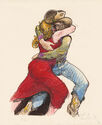
19th, 20th & 21st Century Fine Prints
707-546-7352 · fax 707-546-7924 · web: www.annexgalleries.com · email: artannex@aol.com
Luis Jimenez Biography
Luis Jimenez
American
1940–2006
Biography
Sculptor, painter, and printmaker Luis Jiménez was born in El Paso on July 30, 1940. His parents were of Mexican descent and they lived in the hisotric Segundo Barrio district of El Paso, situated just blocks from the U.S./Mexico border and neighboring the Mexican town of Juarez. Jimenéz frequently crossed over to Juarez to go to mariachi concerts and bull fights, and to help with this father's sign business. This exposure to the life on the border would inform his work throughout his career.
Jimenéz's father owned an electric sign company and taught his son welding, glass molding, and spray painting from an early age. Jimenéz earned his Bachelor's degree in art 1964, having first studied architecture at the University of Texas (UT) Austin and before completing his degree at UT El Paso. He traveled Mexico City to study at the Universidad Nacional Autónoma de México in 1966, and was there for the 1968 Olympics, which proved to be a pivotal time for Jimenéz. There, he was exposed to the work of burgeoning Mexican and Latin American artists, as well as the work of the Mexican muralists Diego Rivera, David Alfaro Siqueiros, and José Clemente Orozco, and the mosaics of Juan O'Gorman, as well as the indigenous architecture and folk art of greater Mexico.
By 1970 Jimenéz had moved to New York City, where he became a part of the Pop Art scene. He began working on his first major sculptural pieces in fiberglass and epoxy, while teaching art to students of color for whom traditional education was too expensive. At the same time, as the Vietnam War raged on, he took notice of the disproportionate number of young black and brown men being sent to the frontlines. His work was greatly influenced by these experiences and began to reflect not only the beauty of Mexican and Latin American people and culture, but the struggles they endured to gain acknowledgment in the colonized world, as well.
In 1972 he was awarded a commission by the Donald B. Anderson and Roswell Museum and Art Center in New Mexico to create two outdoor sculptures. He then found success -- and controversy-- while working in New Mexico as a sculptor of monumental outdoor scupltures throughout the 1970s and '80s. He was awarded two National Endowment for the Arts grants and was commissioned to create works for various cities in the West and Southwest, including New Mexico, Denver, and Houston. His brightly colored, massive sculptures were both objected to and celebrated by the communities in which they were placed. In an interview with the New York Times, Rudolfo Anaya, professor emeritus of history at the University of New Mexico, said of Mr. Jimenez: "The kind of medium he used shocked the art world at first. It was first called outlandish and garish, but it spoke not only to Hispanics but to the world. In the coming years there will be a school of Luis Jimenéz art."
Luis Jimenéz continued to work until his death in his studio in Hondo, New Mexico on June 13, 2006, the result of injuries sustained when one of three pieces from a 32-foot-high sculpture being moved from his studio came loose and pinned him against a steel support. The piece, commissioned by Denver International Airport, depicted a giant mustang horse and had been in development for nearly a decade, according to Jim Moore, former director of the Albuquerque Museum. New Mexico's governor, Bill Richardson, ordered flags around the state to be flown at half-staff for two days following his death.
Information drawn from New York Times obituary and the Latinos in America blog article "A Latino Legacy of Border Cultures," Ricardo Romo, Ph.D, November 21, 2022.


